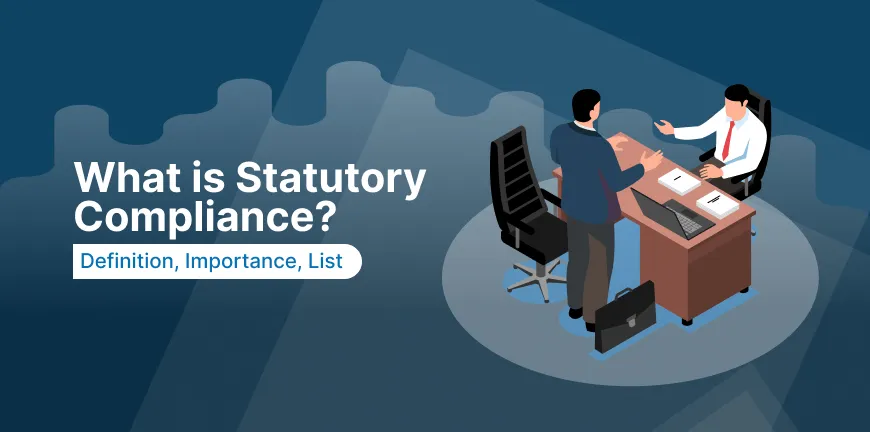
What Is Strategic Human Resource Management? A Complete Guide (2025)
26/08/2025
Driving Efficiency in Recruitment & HR with Digital Innovation
28/08/2025- What Is a Compliance Plan?
- Why Is a Compliance Plan Important for Businesses?
- What are the Key Components of a Compliance Plan?
- How Can You Create an Effective Compliance Plan?
- What are the Benefits of An Effective Compliance Plan?
- What Challenges Do Companies Face in Implementing a Compliance Plan?
- What are the Best Practices Included in a Compliance Plan?
- What Is the Future of Compliance Planning?
- Key Takeaways
- Frequently Asked Questions
“Regulatory compliance is critical to managing risk”- Hendrith Vanlon Smith Jr., CEO of Mayflower-Plymouth.
Do you think compliance is just an obligation to satisfy authorities, or is there more to it? The short answer is yes, compliance plays a major role in dictating a company’s future, not just meeting regulations.
To execute any task effectively and maximise benefits, a well-crafted plan is paramount, and compliance is no different. However, compliance can’t be treated as a standard entity since regulations and laws undergo frequent changes and amendments.
Therefore, a concrete compliance plan with enough room for making improvements according to the regulatory changes seems to be the best way forward.
Let’s help you devise a robust compliance management framework by making you understand the nuances of a compliance plan and how it can be developed and executed using proven techniques. Are you ready?
What Is a Compliance Plan?
Before jumping the gun and creating a compliance management plan, let’s understand the compliance plan definition.
A compliance plan is a framework that involves a collection of internal policies and procedures developed by internal experts or an external compliance agency to ensure an organization aligns with regulations, laws from all aspects, and prevents penalties and legal hassles.
A well-churned-out compliance implementation plan can act as a game-changer that will streamline operations, improve employee engagement, enhance brand reputation with authorities & stakeholders, etc.
The cost of non-compliance can be more than 3X times of investing in planning & compliance, with operational, reputational, & legal risk at stake. Therefore, coming up with a robust compliance plan is non-negotiable to maintaining business continuity and achieving better outcomes.
Why Is a Compliance Plan Important for Businesses?
Business plan compliance has more depth than just an approach of aligning with laws and regulations. At the core, compliance is about creating a solid framework that will motivate companies to operate ethically, responsibly, & legally. A robust compliance plan will act as a guiding torch for companies to meet legal obligations and achieve higher productivity and employee satisfaction. Here are 5 reasons that highlight the importance of an actionable compliance management plan.
1. Regulatory Adherence
A nifty compliance implementation plan makes a company astute, allowing it to meet evolving legal requirements that get more convoluted every year, prevent hefty penalties & legal headaches, and mitigate reputational risks with relative ease.
2. Operational Efficiency
A well-compiled compliance strategic plan refines workflows, gets rid of redundancies, & brings accountability to the forefront. This makes overall productivity shoot up and reduces non-compliance-induced operational disruptions.
3. Risk Mitigation
A structured compliance management plan detects potential threats before they escalate, creates a safety cushion, & minimizes financial, operational, & reputational risks for companies.
4. Stakeholder Trust
Strong planning & compliance will help companies develop trustworthiness among all involved parties. This compliance-first modus operandi strengthens stakeholder confidence & enhances long-term organizational stability.
5. Audit Readiness
A proactive compliance plan audit simplifies documentation, ensures accuracy, & keeps organizations fully prepared for internal & external scrutiny.
What are the Key Components of a Compliance Plan?
Here are the 7 elements of an effective compliance plan:
1. Clear Policies and Standard Procedures
Well-documented policies and procedures are a critical component of a compliance plan. Companies must create a code of conduct, compliance policies & procedures, & policy maintenance manuals to demonstrate commitment towards ethical business practices. It establishes clear expectations, guides employee behaviour, ensures regulatory compliance, & creates a structured framework for consistent operations across the organization.
2. Dedicated Compliance Leadership Team
The management must get a compliance officer & a supporting team on board as part of the compliance implementation plan. Alternatively, companies can collaborate with a reputable compliance agency like ALP Consulting and hand over complete responsibility for end-to-end compliance management. This arrangement brings accountability, proactive risk management, & relentless pursuit towards maintaining ethical standards & regulatory adherence across all departments.
3. Comprehensive Training and Awareness Programs
Companies must put forward tailored training sessions & awareness programs regularly as part of their compliance plan strategy to ensure employees actively participate in all compliance-related endeavours. These targeted learning sessions bestow employees with compliance knowledge, promote ethical behaviour, reduce the instances of non-compliance, & ensure the workforce understands evolving regulations and internal organizational requirements.
4. Open and Transparent Communication Channels
Effective open-ended communication channels that maintain confidentiality and discretion give a solid platform for employees to report concerns, clarify compliance issues, & seek guidance whenever needed. This approach fosters a culture of trust, transparency, & early resolution of potential risks.
5. Ongoing Monitoring and Internal Audits
Regular internal monitoring and audits identify gaps, measure compliance effectiveness, detect irregularities early, and support continuous improvement in governance, risk management, and regulatory frameworks.
6. Consistent Enforcement and Disciplinary Measures
Well-publicized disciplinary guidelines reinforce accountability, discourage non-compliance, and ensure consistent enforcement of standards. This creates a fair and compliant workplace culture across all organizational levels.
7. Swift Corrective Actions for Identified Issues
Timely responses to compliance violations or detected problems demonstrate accountability. This approach prevents recurrence and strengthens overall compliance systems, safeguarding organizational reputation and long-term business integrity.
How Can You Create an Effective Compliance Plan?
Here are the 8 steps involved in an effective compliance plan:
1. Conduct a Compliance Risk Assessment
Carry out a hardcore evaluation of current organizational operations and identify high-risk areas, vulnerable processes, and assess how each operation is stacking up against industry-specific regulations. Create a tailored compliance strategic plan based on the findings.
2. Define Measurable Compliance Objectives
Set lucid, practical compliance goals aligned with the company’s operational strategy. The objectives of the business plan compliance may include reducing incidents that can be considered as violations from authorities, improving audit readiness, increasing transparency, or strengthening stakeholder trust via measurable KPIs.
3. Map Regulatory Requirements to Operations
Systematically align central, state, and industry regulations with your daily workflows. Identify where obligations interject with operations. This ensures compliance activities are embedded seamlessly within organizational practices.
4. Allocate Resources and Budget
Assign sufficient financial, human, & technological resources to the compliance implementation plan. Ensure budgeting supports risk assessments, monitoring systems, reporting tools, & staff time dedicated to compliance responsibilities rather than making it an ad hoc activity.
5. Integrate Technology for Compliance Management
Leverage sophisticated compliance management systems, automation, & compliance plan analytics to track obligations, manage documentation, monitor risks, & generate real-time updates. These technological integrations with compliance activities improve accuracy, transparency, and efficiency.
6. Engage Leadership and Stakeholders
Secure buy-in from leadership and actively involve stakeholders. Leadership commitment drives organizational accountability, ensures resources, & cultivates a culture of compliance across all departments and hierarchical levels.
7. Establish Continuous Review Mechanisms
Schedule periodic reviews of compliance activities, risk environments, & regulatory updates as a part of the compliance plan strategy. Continuous evaluation ensures programs remain relevant, effective, and responsive to changing industry or legal landscapes.
8. Benchmark Against Industry Best Practices
Compare the current compliance framework with peer companies and regulatory guidance. Benchmarking reveals improvement opportunities, highlights strengths, & ensures the compliance implementation plan aligns with evolving standards and industry excellence.
What are the Benefits of An Effective Compliance Plan?
Here are the 5 key benefits of an effective compliance plan:
1. Risk Reduction
An all-round compliance management plan helps in preventing legal, financial, & reputational risks to the maximum extent by proactively tackling regulatory requirements & potential violations before they fall into non-compliance zones.
2. Operational Efficiency
Streamlined business plan compliance overcomes redundancies, refines workflows, enhances productivity, & ensures smoother rapport across departments & business functions.
3. Enhanced Reputation
Best practices devised under a compliance management plan help in building organizational credibility, fostering stakeholder trust, attracting partnerships, & strengthening long-term brand value in competitive markets.
4. Audit Preparedness
A robust compliance implementation plan ensures accurate documentation, 24×7 monitoring, & readiness for external compliance audits or inspections from concerned authorities and the internal vigilance team. This approach reduces penalties, disruptions, & compliance costs.
5. Employee Accountability
Clear compliance frameworks promote ethical behaviour, reinforce responsibility, & empower employees to make informed and smarter decisions aligned with organizational & legal standards.
What Challenges Do Companies Face in Implementing a Compliance Plan?
Here are the major challenges faced by companies while implementing a compliance plan:
1. Keeping Up with Regulatory Changes
Frequent updates in central, state, and industry-specific regulations make it arduous for companies to create a standard compliance implementation plan, make real-time changes in policies. The dynamic regulatory landscape can trigger gaps in compliance & give rise to legal consequences.
2. Limited Resources and Budget Constraints
Companies often find it cumbersome to allocate sufficient financial, human, and technological resources for compliance initiatives, resulting in a half-baked compliance strategic plan, weak monitoring, & inconsistent implementation across business functions.
3. Employee Awareness and Engagement
Expecting employees to fully understand compliance right from the start is out of the question. The lack of awareness or stiff resistance to change from the workforce can derail the compliance management plan, increasing risks of non-compliance & ethical breaches.
4. Complex Operational Structures
Companies with multiple departments, geographies, or business units face challenges in implementing a common business plan compliance. These variations can lead to inconsistencies, fragmented processes, and greater risks of overlooking regulatory obligations.
5. Data Management and Documentation
Maintaining accurate, accessible, and audit-ready documentation is a complex ongoing process. Poor recordkeeping or decentralized systems can affect compliance plan audits as they hinder monitoring, reporting, and demonstrating compliance during regulatory inspections or audits.
What are the Best Practices Included in a Compliance Plan?
Here are 5 best practices that will make the compliance plan more effective:
1. Regular Risk Assessments
Conduct comprehensive risk assessments periodically (at least every 3 months) to identify vulnerabilities, evaluate compliance gaps, & implement preventive measures. This proactive approach enhances organizational resilience and preparedness against regulatory or operational risks.
2. Tailored Policies and Procedures
Develop customized policies reflecting organizational risks, industry regulations, & business operations. This ensures employees understand expectations clearly while maintaining consistency, transparency, and accountability across all levels.
3. Ongoing Compliance Training
Deliver regular, role-specific training programs to enhance awareness, build ethical decision-making skills, and keep employees updated on evolving compliance regulations. This fosters a culture of responsibility and accountability among employees and managers.
4. Robust Monitoring and Reporting Systems
Implement continuous monitoring tools & transparent reporting mechanisms that track compliance activities, detect irregularities early, and provide actionable insights. This approach strengthens accountability and prevents violations.
5. Continuous Improvement through Reviews
Regularly review and update compliance frameworks, incorporating feedback, benchmarking against industry best practices, and aligning with evolving laws. This arrangement ensures long-term effectiveness and adaptability.
What Is the Future of Compliance Planning?
Here are the 5 ways the compliance plan will evolve in the future:
1. Technology Integration
The compliance plan strategy will leverage AI, automation, & analytics on a large scale to monitor risks, streamline documentation, predict possible violations, & ensure real-time regulatory adherence with minimal human intervention.
2. Data Privacy and Cybersecurity Focus
With rising digital threats, the compliance management plan must prioritize robust data governance, cybersecurity protocols, & privacy protection aligned with global data regulations like GDPR & DPDP.
3. Globalized Regulatory Alignment
As businesses expand internationally, planning & compliance must evolve to address multi-jurisdictional laws, cross-border trade rules, and diverse regulatory expectations seamlessly.
4. Sustainability and ESG Integration
Future business plan compliance will embed environmental, social, and governance (ESG) standards, ensuring businesses meet stakeholder expectations and align with sustainability-focused regulatory frameworks.
5. Adaptive and Continuous Improvement
Compliance planning will shift from static frameworks to dynamic, continuously evolving systems that anticipate regulatory changes and embed resilience into organizational culture.
Key Takeaways
- A compliance plan is an internal framework ensuring adherence to laws, regulations, and ethical standards.
- It prevents penalties, legal issues, and reputational risks by embedding compliance in daily operations.
- Developed by experts or agencies, it formalizes compliance policies tailored to business and industry needs.
- The framework streamlines operations, enhances employee accountability, and promotes a culture of responsibility and integrity.
- Investing in compliance planning saves costs compared to the expensive consequences of non-compliance or regulatory violations.
Frequently Asked Questions
1. What is the purpose of a compliance plan?
A compliance plan ensures legal adherence, reduces risks, fosters accountability, strengthens ethics, and protects organizations from penalties or reputational damage.
2. How do you implement a compliance plan in a company?
A compliance implementation plan involves risk assessment, setting policies, training employees, monitoring compliance, addressing violations, and continuously improving processes to ensure organizational accountability.
3. What are the 5 key elements of a compliance plan?
The key elements of a compliance management plan include risk assessments, tailored policies, training programs, monitoring mechanisms, and corrective actions, ensuring legal adherence and organizational integrity.
4. How often should a compliance plan be audited?
Compliance plans should be audited annually or more frequently, depending on industry regulations, organizational risks, and evolving legal requirements.
5. What is the difference between a compliance plan and a compliance strategy?
A compliance plan outlines operational steps, whereas a compliance strategy establishes the long-term direction, priorities, and frameworks for achieving sustainable regulatory adherence.
6. Can small businesses benefit from a compliance plan?
Yes, a compliance plan helps small businesses avoid penalties, build credibility, manage risks, and maintain efficiency despite limited resources.
7. What role does analytics play in compliance planning?
Compliance plan analytics identifies risk patterns, predicts compliance breaches, tracks performance, and provides actionable insights to improve decision-making and proactive planning.
8. How do compliance plans help avoid legal issues?
Compliance plans ensure laws are followed, violations are prevented, risks are mitigated, and documentation is maintained, reducing the chances of penalties or lawsuits.
9. What industries require strict compliance planning?
Industries like healthcare, finance, manufacturing, energy, and pharmaceuticals demand strict compliance planning due to complex regulatory requirements.
10. Who is responsible for managing a compliance plan in an organization?
Typically, a compliance officer, supported by leadership and designated teams, manages, monitors, and enforces compliance across the organization.
Contact Us For Business Enquiry

Hariharan Iyer
Hariharan Iyer is the Vice President – Operations at ALP Consulting, bringing over 40+ years of experience in HR outsourcing and labour law compliance. He leads end-to-end HRO operations, ensuring process efficiency, statutory compliance, and seamless service delivery for clients across industries. With a strong background in labour law governance and workforce management, Hariharan plays a key role in driving operational excellence and compliance-led HR solutions at ALP Consulting.




